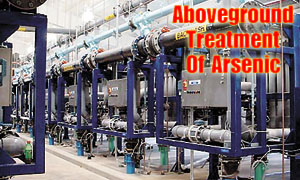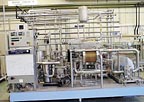
Membrane filtration can remove a wide range of contaminants from water. The process separates contaminants from water by passing it through a semipermeable barrier or membrane. This technology typically can reduce arsenic concentrations to less than 0.05 milligrams per liter, and, in some cases, has reduced arsenic concentrations to less than 0.01 milligrams per liter.
However, the effectiveness of membrane filtration is sensitive to a variety of untreated water contaminants and characteristics. It also produces a larger volume of residuals and tends to be more expensive than other arsenic treatment technologies. Therefore, it is used less frequently than precipitation/coprecipitation, adsorption and ion exchange. It is most commonly used to treat ground water and drinking water, or as a polishing step for precipitation processes.
There are four types of membrane processes:
- reverse osmosis
- nanofiltration
- microfiltration
- ultrafiltration
All four are pressure-driven and are categorized by the size of the particles that can pass through the membranes or by the molecular weight limit of the membrane. The force required to drive fluids across the membrane depends on the pore size; nanofiltration and reverse osmosis require a relatively high pressure (50-150 psi), while microfiltration and ultrafiltration require a relatively low pressure. The low-pressure processes primarily remove contaminants through physical sieving, and the high-pressure processes primarily remove contaminants through chemical diffusion across the permeable membrane. Because arsenic species dissolved in water tend to have relatively low molecular weights, only nanofiltration and reverse osmosis membrane processes are likely to effectively treat dissolved arsenic. Microfiltration has been used in conjunction with precipitation/coprecipitation to remove solids containing arsenic. Ultrafiltration is impractical for these purposes.
Membrane filtration processes generate two treatment residuals from the influent waste stream – a treated effluent and a rejected waste stream of concentrated contaminants.
Reverse osmosis is a high-pressure process that primarily removes smaller ions typically associated with total dissolved solids. The molecular weight cutoff for reverse osmosis membranes ranges from 1 to 20,000, which is a significantly lower limit than for nanofiltration.
The molecular weight cutoff for nanofiltration membranes ranges from approximately 150 to 20,000. Nanofiltration is a high-pressure process that primarily removes larger divalent ions associated with hardness (e.g., calcium) but not monovalent salts (e.g., sodium and chlorine). Nanofiltration is slightly less efficient than reverse osmosis in removing dissolved arsenic from water.
Microfiltration is a low-pressure process that primarily removes particles with a molecular weight above 50,000 or a particle size greater than 0.05 micrometers. The pore size of microfiltration membranes is too large to effectively remove dissolved arsenic species, but microfiltration can remove particulates containing arsenic and solids produced by precipitation/coprecipitation processes.

Report Abusive Comment